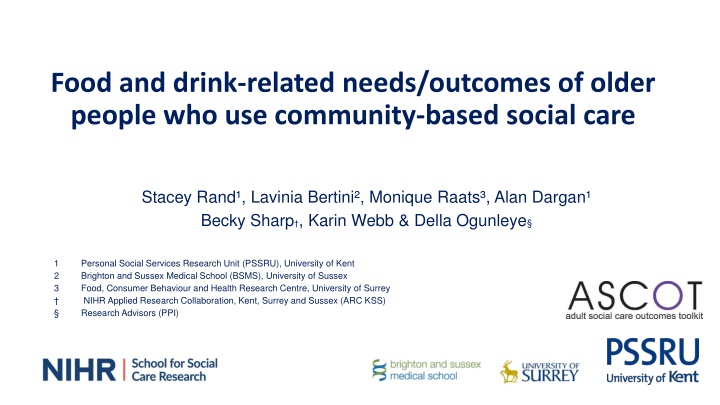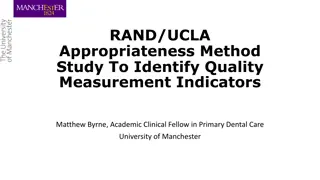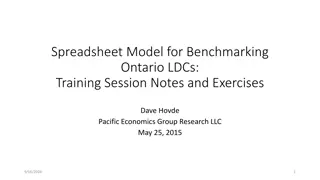
Food and Drink Needs of Older Adults in Community Social Care
Explore the food and drink-related needs and outcomes of older adults in community-based social care services to address malnutrition risks and enhance quality of life. This research delves into factors influencing nutrition and hydration among older individuals.
Download Presentation

Please find below an Image/Link to download the presentation.
The content on the website is provided AS IS for your information and personal use only. It may not be sold, licensed, or shared on other websites without obtaining consent from the author. If you encounter any issues during the download, it is possible that the publisher has removed the file from their server.
You are allowed to download the files provided on this website for personal or commercial use, subject to the condition that they are used lawfully. All files are the property of their respective owners.
The content on the website is provided AS IS for your information and personal use only. It may not be sold, licensed, or shared on other websites without obtaining consent from the author.
E N D
Presentation Transcript
Food and drink-related needs/outcomes of older people who use community-based social care Stacey Rand , Lavinia Bertini , Monique Raats , Alan Dargan Becky Sharp , Karin Webb & Della Ogunleye 1 2 3 Personal Social Services Research Unit (PSSRU), University of Kent Brighton and Sussex Medical School (BSMS), University of Sussex Food, Consumer Behaviour and Health Research Centre, University of Surrey NIHR Applied Research Collaboration, Kent, Surrey and Sussex (ARC KSS) Research Advisors (PPI)
Acknowledgements This presentation summarises independent research funded by the National Institute for Health and Care Research School for Social Care Research (NIHR SSCR). The views expressed are those of the authors and not necessarily those of the NIHR SSCR, the NIHR or the Department of Health and Social Care. Images are from the Centre for Better Ageing s library of age-positive images. Further information about ASCOT is available here: www.pssru.ac.uk/ascot
Background An estimated 1.3 million UK older adults, aged 65+, are undernourished Malnutrition and dehydration are major causes of health deterioration Older people using social care services (incl. homecare) are at higher risk Complex inter-related risk factors How do we understand food and drink-related needs/outcomes ? Thinking beyond (risk of) malnutrition and dehydration to also consider quality of life Community-based services play a vital role in supporting people But their role is relatively underexplored
Aims and Objectives What is already known about food and drink-related needs and outcomes* of older adults using homecare? What is the profile of and factors related to the food and drink-related needs and outcomes* in England? * Defined broadly, to include food and drink care-related quality of life
Methods 1. Scoping literature review 2. Analysis of the English Adult Social Care Survey (ASCS) 3. Developing a guide to findings and recommendations
Work Package (WP) 1 - Scoping Literature Review Objectives Conduct a systematic search of published works To gain an overview of the international literature on food and drink-related needs/outcomes of older adults using homecare What is already known and where are the gaps?
Work Package (WP) 1 - Scoping Literature Review Eligibility criteria Published reports of research studies (journal articles, grey literature) Published in English language Published after 2000 Relates to: Older adults, aged 65 or over Using homecare, and Food and drink-related needs or outcomes Including: (mal)nutrition, (de)hydration and/or quality of life
Database searches Title/abstract review Full-text review & charting Qualitative analysis and interpretation
Work Package (WP) 1 - Scoping Literature Review Understandings of food and drink needs/outcomes Narratives around (mal)nutrition health deterioration hospitalization Person-centred care for food/eating and drink/drinking What is the role of homecare in supporting older adults? In most studies, the role of homecare was not explicitly considered Some studies explore person-centred care and the challenges to delivery Innovations Combination with other services or assistive technology Improving or supporting communication between family/unpaid carers, healthcare professionals, homecare and/or other services
WP2 - Analysis of Adult Social Care Survey Dataset Annual survey of adults using publicly-managed social care in England Adult Social Care Outcomes Toolkit (ASCOT)
food & drink care-related quality of life Based on capability approach (i.e. the ability to do and be, as you wish ) = Ideal state = No needs = Some needs = High-level needs Needs met Unmet needs
Invited Sample N Respondent Sample N Response Rate % Unmet need ASCS wave/year N (%) 1. 2010/11 67,890 29,650 43.7% 1,273 (4.3%) 2. 2011/12 63,947 28,204 44.1% 1,246 (4.4%) 3. 2012/13 68,213 28,618 42.0% 1,311 (4.6%) 4. 2013/14 71,253 29,255 41.1% 1,390 (4.8%) 5. 2014/15 72,739 28,449 39.1% 1,665 (5.9%) 6. 2015/16 73,534 28,584 38.9% 1,714 (6.0%) 7. 2016/17 73,342 27,902 38.0% 1,726 (6.2%) 8. 2017/18 70,536 23,582 33.4% 1,506 (6.4%) 9. 2018/19 76,052 25,206 33.1% 1,616 (6.4%) 10. 2019/20 77,592 23,598 30.4% 1,561 (6.6%) 11. 2020/21 9,126 2,535 27.8% 147 (5.8%) An increase in % with unmet needs from 4.3% to 8.1% 12. 2021/22 81,474 23,193 28.5% 1,879 (8.1%) TOTAL 805,698 298,776 37.1% 17,034 (5.7%) Voluntary survey due to pandemic Decreasing response rate to ASCS
WP2 - Analysis of Adult Social Care Survey Dataset What are the factors* related to unmet need? Ethnicity Sex/gender Health and care needs (difficulty with everyday activities, anxiety & depression) Informal help from family & friends Suitability of home design Financial contribution towards cost of care By the person, their family or person & family (combined) Survey year Type of local authority *These are limited by data available in the ASCS dataset or linked data.
B SE OR .891 1.160 Gender: male Ethnicity: categories other than white Local authority Unitary Shire county Inner London Outer London I/ADLs with difficulty Eating and drinking with difficulty Suitability of home Meets most needs Meets some needs Totally inappropriate Informal care / Practical help Outside home Inside and outside home None Privately purchased care ( top up ) Yes, family money Yes, own & family money None Response by proxy report -.115*** .148*** .021 .030 Preliminary analysis . Analysis is still ongoing -.014 -.052 .026 .027 .034 .030 .005 .025 .986 .949 1.224 1.085 1.128 1.646 .202*** .082** .121*** .498*** .657*** 1.429*** 1.842*** .024 .026 .040 1.929 4.176 6.310 Base category Local authority - metropolitan Suitability of home - meets all needs Informal care - inside home Privately purchased care - own money 1.347*** .286*** 1.665*** .027 .047 .033 3.845 1.332 5.283 -.047 .078 .038 .058 .020 .030 .954 1.081 .849 1.101 ** p<0.01 *** p<0.001 -.164*** .096**
B SE OR Survey year 2012 2013 2014 2015 2016 2017 2018 2019 2020 2021 2022 Constant McFadden s pseudo r 2 .008 .025 .036 .047 .046 .046 .044 .044 .044 .046 .045 .046 .107 .044 .053 1.008 1.025 1.037 1.146 1.196 1.221 1.196 1.238 1.259 1.084 1.567 .005 12.0% .136** .179*** .199*** .179*** .213*** .230*** .080 .449*** -5.300*** Base category Survey year (2011) ** p<0.01 *** p<0.001 12,366, df = 29, p<.001
WP2 - Analysis of Adult Social Care Survey Dataset Food and drink care-related QoL ( outcome ) = care intensity + care quality + functional care needs + individual characteristics ASCS dataset does not include individual-level care intensity Estimate of average care intensity per older person using services per LA From 2015 to 2022 only, due to data availability Results are similar except . Ethnicity no longer significant Privately purchased care - with own and family money significant (higher likelihood of unmet need) Survey year, 2021 significant (lower likelihood of unmet need) * Survey year, 2022 significant (higher likelihood of unmet need) Average care intensity per person, by LA - significant (lower likelihood of unmet need) * Survey conducted on a voluntary basis vs mandatory, due to the pandemic.
Summary and Conclusions Estimated 4% to 8% of older adults living at home using social care have unmet food and drink care-related needs % increased between 2011 and 2022 Factors related to unmet need . Survey year (i.e. an increase over time) Does this reflect wider sector impacts (e.g. workforce shortages, chronic underfunding) or context (e.g. pandemic, cost of living increases)? Average intensity of homecare per older person in each local authority This indicates that social care investment works overall But we are limited by what we can consider in the dataset, so it is hard to say more Further analysis Data linkage but a challenge with current data collection and reporting New possibilities based on changes to social care data collection in England ?
WP3 Brief guide to key findings and Recommendations Development, Dissemination and Implementation Share preliminary findings from WP1/2: Identify key stakeholders and reasons for interest Explore how the findings could be used to inform, engage, influence Development of a brief guide - summarising key findings and recommendations, tailored to different audiences Consider contextual issues, in relation to implementation Facilitate discussion and commitment to further research Blog post(s) Informed by the Knowledge Exchange, Impact and Engagement (KEIE) Plan Project guide and recommendations On-line event (spring 2024)
Any questions? s.e.rand@kent.ac.uk @DrStaceyRand
Food and Care Food is loaded with meaning, is grown and cooked by some people for others, who eat it jointly or alone, with all the social specificities this entails while it is also physical. Living bodies die if they go without it. Harbers, Mol, Stollmeyer, 2002,p.207 The language and practices of care are underrepresented in public debates.
Disseminating and implementing the findings Two questions for you: 1. Who is the target audience (i.e., who may be interested in this research)? 2. What terminology would you use to disseminate the findings (i.e., how would you frame the issue)?
Who is the target? Audience/stakeholders Adult Social Care Commissioners, providers, care workers Adults with support needs, using care services Family and friends Healthcare professionals Public Health Researchers and academics
Framing the issue(s) Public Health a focus on healthyeating ; eating and drinking are framed as individual choices ; impact of food poverty but what about care poverty? Medicine Nutrition and illness ; eating and drinking are framed as naturalprocesses . Social Care Quality of life or supporting a person to live well, i.e., person-centred care; eating and drinking are framed as a task , i.e., caring : wilful and responsive, creative and adaptive, infused by desire and attuned to the circumstances (Mol, 2021,p.88).
Why is it important? IMPACT FUNDS AWARENESS INCLUSION
Any questions? Contact us: Dr Stacey Rand: s.e.rand@kent.ac.uk Dr Lavinia Bertini: L.Bertini@bsms.ac.uk www.pssru.ac.uk/foodanddrink/ Project website:






















